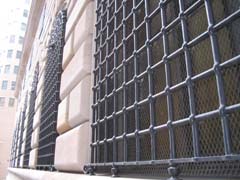trade
event
 |
What could you buy with $90 billion? Not much, unfortunately, if it's in gold bullion. And that's assuming you can even get to it. One of the largest repositories of gold in the world is the New York Fed's vault under Manhattan island. Sinking 6 stories deep, it touches the bedrock and is reinforced in so many different ways, workers at the lowest level didn't even realize the World Trade Center was under attack until they were told by ground-level employees.
In this rare off-season tour of the New York Fed, we learned much about security, the value of collateral such as gold, and of course, financial policy making and regulation. Although much of it was sophisticated, Peter Bakstansky, Senior Vice President, Public Information made things relatively easy to understand.
First, don't think that just because you saw "Die Hard 3", you're getting in there. The building isn't as accessible as the movie makes it appear to be. And even if you found some way to blow your way inside, the main vault where the gold is kept is virtually inaccessible between 5pm and 9am the next business day. But assuming you decided to make a daring broad-daylight break-in through one of the two entrances (that can close in 7-seconds or less), and somehow get past the armies of security personnel, and the overkill quadruple security locks on each internal vault, you really can't just stow 50 lb gold bricks in your pockets for a quick dash. The gold is so heavy, the building can sink if it wasn't attached to the bedrock under the island. But let's say you figured all that out, and decided to make a Mission Impossible escape from the roof, you might want to keep in mind the hidden rocket launchers they keep up there and don't announce to the public. No sir, you'd have to be an X-Man to get out of there. And even if you were, you'd have to be a country to be able to sell gold bricks that are virtually worthless. That's right, gold, it appears, lost its tangible value years ago, when currencies began to attach themselves to the dollar and the U.S.'s reputation as a reliable borrower. Although it still serves as collateral, the same way your house would, the faith of other governments in the United States being able to pay back its debt is so strong, the gold is mainly for show.
And that presents a good segue into my next question - why gold, instead of diamonds, platinum, or any other precious, rare commodity? Because gold is easy to manipulate into any shape. You can mold it into bricks for storage and precise shave pieces of it to alter its valuable in a controlled manner. You can't do that to diamonds.
The NYFed is the strongest of 12 banks that regulate financial and monetary policy in this country. It's the one that conducts the largest amount of business with other financial institutions, called market operations, which bring in an excess of $3 billion annually, which the NY Fed mostly disburses back to the U.S. gov. Every activity undertaken by this institution is designed to stabilize the financial system in this country.
There are 9 directors broken up into 3 classes on its board composed of representatives of banks and executives representing the public. Class A are bankers elected by banks. Class B are CEO-types also elected by banks. Class C are also CEO-types, but they're appointed by the other 12 governors of the other 12 fed banks. I asked Peter how I may get elected or appointed, and basically, it's a really, really, really longshot.
Did you know that Citigroup is so big, they're no longer regulated by the SEC, but by the Fed. These and other interesting tid-bits were part of our two-hour long tour, which I give 4 pluses.
Write to Al Berrios at editor@alberrios.com
Related alberrios.com Sections
Disclaimer:
The recommendations, commentary and opinions published herein are based on
public information sometimes referenced via hyperlinks. Any similarities or
likeness to any ideas or commentary from any other sources not referenced
is purely coincidental. al berrios & co. cannot control any results occurring
from advice obtained from this publication nor any opinion(s) conveyed by
any reader of this publication.
(c) 2004. All Rights Reserved. al berrios & company, inc. Published
by al berrios & co. This Report may not be reproduced or redistributed
in any form without written permission from al berrios & co., subject
to penalty.